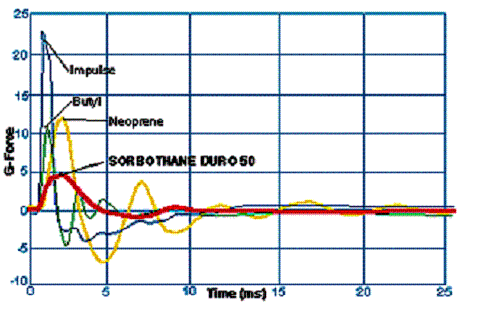
Vibration Damping Techniques
After creating a housing that is adaptable to the RDS, the next problem that needed to be considered by the team was vibration damping. The group decided to address this problem by utilizing multiple vibration dampening substrates at four locations throughout the design. These locations are as follows: at the RDS mounting point, through a floating bolt mechanism, throughout the array material, and a substrate under each microphone.
Different types of substrates were used in order to ensure all vibrations were successfully mitigated. After careful research, the best substrate for the floating bolt mechanism was found to be Sorbothane. Sorbothane is a proprietary, visco-elastic polymer. The method behind this material's vibration damping characteristics is that, when compressed, it turns mechanical energy into heat, thus dissipating the amount of vibration through its structure. Shown below is an impulse response graph comparing Sorbothane to other isolation materials.

Copyright Sorbothane Inc.
As evidenced by the graph, Sorbothane is an excellent choice for the problem at hand due to its excellent impulse response damping.
Shown below is also a Pro/E diagram of our floating bolt mechanism and how the Sorbothane bushings dissipate energy:

Acoustic foam is the final vibration damping material used in our design. The purpose of the foam at this location is to help damp any remaining impulse energy that may have propagated to the microphone location. Due to it's low density and composition, the acoustic foam dissipates a great deal of impulse energy. Shown below is also a depiction of precisely how acoustic foam was used as a substrate under each microphone: